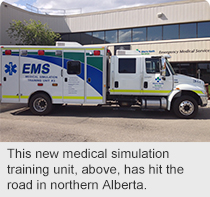
January 26, 2015
Story and photo by Kerri Robins
It’s a “sound stage” that can literally make the difference between life and death.
Emergency Medical Services (EMS) in northern Alberta now has its own medical simulation training unit (MSTU) to provide scripted training scenarios for its staff.
“Keeping our emergency services staff current on medical practices and procedures is critical and we believe in perfecting our craft through simulation,” says Brent Thorkelson, Senior Staff Development Officer, Emergency Medical Services, Alberta Health Services.
 “Medical treatments and practices change all the time and we find simulating a real-life event is the most effective way in keeping staff up to date.”
“Medical treatments and practices change all the time and we find simulating a real-life event is the most effective way in keeping staff up to date.”
Basically a retrofitted ambulance, the MSTU is equipped with its “lead actor” — a patient simulator that is wirelessly connected so vital signs such as heart and blood pressure can be monitored by staff.
The patient simulator also talks, making the training event as realistic as possible in mimicking a real-life emergency.
As well, a paramedic clinical educator is on-site with a computer and state-of-the-art software to provide information to the trainees that the patient simulator can’t — for example, if skin colour is turning bluish.
If the wrong treatment is given, the clinical educator can respond by programming in a reaction from the patient simulator.
Each event is also attended by a training facilitator who acts as a bystander, for example a family member, providing information to the emergency responders treating the patient.
The MSTU is fully loaded with rotating cameras and audio equipment to monitor the actions of the staff.
Each training event concludes with a debriefing of the crew to ensure critical teaching points have been covered. Most training events will occur at area hospitals or at EMS stations.
“Our goal is to provide a training opportunity for every emergency service practitioner in Alberta at least once a year,” says Thorkelson.
This simulation training unit was given to northern Alberta, thanks to the Regional EMS Foundation of Grande Prairie which funded the MSTU at a cost of $200,000. The unit joins two others in the province.
Cheryl Weaver, Chair of the Regional EMS Foundation, is pleased to be part of the efforts to provide training for northern Alberta emergency services staff.
“This is a pretty sophisticated unit and a lot of people worked hard helping raise the funds to support training for our emergency services,” says Weaver.
“I’m proud of my community and the high level of commitment and investment they put into their local health care.”
For more information visit the Regional EMS Foundation in Grande Prairie at remsfoundation.org.